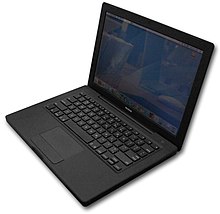Original discrete polycarbonate model
The original MacBook, available in black and white cases, was released on May 16, 2006, and used the Intel Core Duo processor and 945GM chipset, with Intel's GMA 950 integrated graphics on a 667 MHz front side bus. Later revisions of the MacBook moved to the Core 2 Duo processor and the GM965 chipset, with Intel's GMA X3100 integrated graphics on an 800 MHz system bus.[4] Sale of the black polycarbonate MacBook ceased in October 2008 after the introduction of the aluminum MacBook.
While thinner than the iBook G4 that it replaced, the MacBook was wider than the 12-inch model due to its widescreen display. In addition, the MacBook was one of the first (the first being the MacBook Pro) to adopt Apple's MagSafe power connector and it replaced the iBook's mini-VGA display port with a mini-DVIdisplay port. The iBook's discrete graphics chip was initially replaced by an integrated Intel GMA solution, though the latest revisions of the MacBook were upgraded with the more powerful Nvidia GeForce 320M.[5]
While the MacBook Pro largely followed the industrial design standard set by the PowerBook G4, the MacBook was Apple's first notebook to use features now standard in its notebooks: the glossy display, the sunken keyboard design, and the non-mechanical magnetic latch. With the late 2007 revision, the keyboard received several changes to closely mirror the one that shipped with the iMac, by adding the same keyboard shortcut to control multimedia, and removing the embedded virtual numeric keypad and the Apple logo from the command keys.[6]
Also offered in a more expensive black model until the introduction of the later unibody aluminum MacBook, the polycarbonate MacBook was the only Macintosh notebook to be offered in more than one color since the iBook G3 (Clamshell).
[edit]Ports
The ports are all on the left edge; on early models, from front to back, they are: Kensington Security Slot, audio in/out, two USB 2.0 ports, FireWire 400, mini-DVI, Gigabit Ethernet, MagSafe power connector.
The front edge features a pill-shaped power light and a round black infrared receiver, for Apple Remote; the right edge features only the disc slot.
[edit]User serviceability
The polycarbonate Intel MacBook is easier for users to fix or upgrade than its predecessor. Where the iBook required substantial disassembly to access most internal components, including removal of the keyboard and RAM,[7] users need only to remove the polycarbonate MacBook's outer shell to access almost any interior component. Replacing the hard drive and memory requires merely the removal of the battery, and Apple provides do-it-yourself manuals for these tasks.[8]
[edit]Quality problems
Some early polycarbonate MacBook models suffered from random shutdowns, occurring to owners who have owned their MacBooks for some amount of time.[9] They were resolved through replacement of the CPU heatsink and firmware updates.[10]
There were also cases reported of discolored or chipping palmrests. There were many instances of the edges of the palm rest and screen bezel splitting and thin strips peeling off. In such cases, Apple asked affected owners to contact AppleCare.[11]
There were problems with batteries on some models from 2007 not being read by the MacBook. This is caused by a logicboard fault and not a fault with the battery.
In February 2010, Apple announced a warranty extension and recall for MacBooks bought between 2006–2007 for hard drive issues. This is caused by heat and other problems.[12
